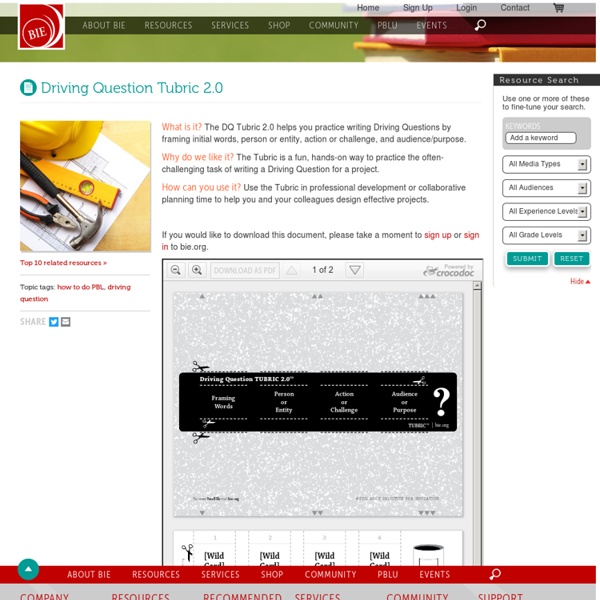



PBL - Over 25 Links Uncovering Project Based Learning Resources On The Web BIE – Also known as the BUCK Institute for Learning. Check out this site for activities, videos, handouts, and research. BIE is the mother lode of PBL and its site is one of the best. BIE Videos - What Is PBL Video – A great collection of videos that demonstrate PBL and its best practices. BIE Tools – PBL Project Search - Here you will find a collection of 450 proven lesson plans to set any PBL desire into action. BIE PBL Research Library - Here you will find a wonderful collection of research summaries, full papers, and presentation materials. BIE PBL Do IT Your-Self Kit – BIE has developed this Do-It-Yourself (DIY) Tutorial based on the PBL Toolkit books and highlights from the popular PBL 101 Workshop. BIE FreeBies – What a wonderful collection of documents perfect for PBL. BIE Electronic Project Planner – This is an awesome place for educators to electronically create their own PBL lessons using a unique digital form. West Virginia Teach 21 PBL Learning Reviews Edutopia The Rest
Project Based Learning and iPads/iPods Introducing an irresistible project at the beginning of a unit of study can give students a clear and meaningful reason for learning. Plus, they end up with a product or result that could possibility make a difference in the world! In project based learning students are driven to learn content and skills for an authentic purpose. PBL involves students in explaining their answers to real-life questions, problems, or challenges. Technology can be helpful throughout a project, whether students use iPads, Chromebooks, Android tablets, laptops, or desktops.
Project-Based Learning Professional Development Guide An overview of the Edutopia professional development guide for teaching how to use project-based learning in the classroom. Edutopia.org's Project-Based Learning professional development guide can be used for a two- to three-hour session, or expanded for a one- to two-day workshop, and is divided into two parts. Part one is a guided process, designed to give participants a brief introduction to project-based learning (PBL), and answers the questions "Why is PBL important?", "What is PBL about?" Part two assigns readings and activities for experiential PBL. Students Follow the Butterflies' Migration: Teacher Frances Koontz shows students a symbolic butterfly sent from children in Mexico. The Resources for PBL page includes a PowerPoint presentation (including presenter notes), which can be shown directly from the website or downloaded for use as a stand-alone slide show, and sample session schedules. Continue to the next section of the guide, Why Is PBL Important?
Project-Based Learning: An Overview Student: We would place the dome right here, for instance. Narrator: These sophomore geometry students in Seattle, have a problem. And they're excited about solving it. Eeva: The problem that they have to solve, is how do you design a state of the art high school in the year 2050, on a particular site. Student: Here's the fire eliminator. Narrator: In Lackawanna, Pennsylvania, these fifth graders are designing a tool to put out fires in space. Student: If you turn it on high, it sucks up the fireballs. Narrator: In Newport News, Virginia, these second graders are investigating cystic fibrosis. Student: One of our students has CF, and we're trying to learn about CF, to see what it is, how it works. Narrator: In Hawaii, high school students are building electric cars, and racing them. Student: Yeah, yeah, put something right there. Student: We did a experiment on dead worms. Teacher: See the different type of fish down here? Narrator: Each class picks a topic to study for the semester.